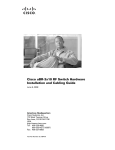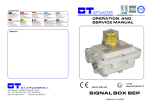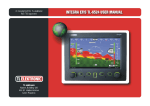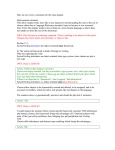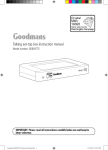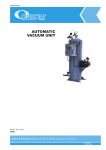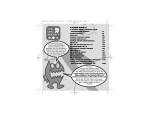Download Manual
Transcript
…............................................... Model: CH104 EZee Fold Portable Power Wheelchair Model: CH4050 EZee Life™ Products 34 Futurity Gate, Unit 15 Concord, Ontario L4K 1S6 Limited Warranty: Ezee Life™ products carry a one year warranty against manufacturing defects, faulty materials and workmanship only. Any alterations, misuse, abuse, or accidental damage voids this warranty. Ezee Life™ reserves the right to replace or repair any part that has become defective. The warranty does not extend to consequential costs resulting from the fault or defect of the product: freight and travel costs, loss of earnings, or other expenses that one may incur. Warranty is valid for the original purchaser only and the original receipt must be presented before any warranty options are considered. Please also be prepared to provide the date of purchase and serial number. Table of Contents I. GUIDANCE FOR USE 3 II. PRODUCT SAFETY SYMBOLS 4 III.TECHNICAL SPECIFICATIONS 5 IV. FEATURES 6 V. ELECTROMAGNETIC INTERFERENCE WARNING 7 VI. SAFETY 8 VII. INSTALLATION GUIDE 13 VIII. OPERATION GUIDE 14 IX. BRAKING 17 X. BATTERY 18 X. UNFOLDING AND FOLDING 22 XII.TROUBLESHOOTING 26 XIII. WARRANTY 28 XIV. PACKING LIST 30 2 I. Guidance for Use This manual must be read and understood completely before your first use. If you have dif ficulty in understanding the warnings, notes and instructions in this owner’s manual,or require additional assistance, please contact your authorized provider or distributor to obtain professional guidance and help. Failure to follow the instructions on this manual can lead to your safety being at risk as result of improper usage, and voiding the warranty. Authorized Provider: __________________________________ Address: ___________________________________________ Phone Number: ______________________________________ Purchase Date: ______________________________________ 3 . Product Safety Symbols The following symbols are used to identify warnings, mandatory actions and prohibited actions. It is essential that you fully understand and completely familiarize yourself with these symbols before operating wheelchair for the first time. Read and follow the instructions provided in this manual. Safety warning sign or an indication of a dangerous operation that may endanger your safety or the safety of others. Class equipment (Canada) / Class equipment (USA). Do not use any mobile phones, walkie talkies, electronic devices or any other radio transmitters while operating. Finger crush / pinch point. Store in a clean and dry condition; away from rain, snow, ice, salt and water. Test of EMI/RFI at an immunity level of 30 V/m has been passed. Corrosive substance contained in the battery Danger of explosion Do not use batteries with different amp-hour (Ah) capacities, No mix use of old and new batteries. Always replace both batteries at the same time. Keep tools and other metal objects away from battery terminals. If contacted, shortcircuit or electric shock may occur and cause injury. Flammable material, avoid exposure to heat source such as open flame or sparks. Avoid transporting the batteries along with flammable or combustible objects. Disposal and recycle 4 . Technical Speci fications Dimensions (Unfolded): L x W x H 34.3 x 12.2 x 36.6 in / 860 x 560 x 930 mm Dimensions (folded): L x W x H 22.4 x 12.2 x 26.4 in / 560 x 300 x 670 mm Suggested User Weight Max: 250 lbs (120kg) Net weight: 25.6 kg (with 3 battery )/22.9 kg (with 1 battery) Gross weight: 29.6 kg (with 3 battery )/26.9 kg (with 1 battery) Full Charge Range: 12 km* per battery Max Speed: 6 km/h Turning radius: 31.5 in / 800 mm *Will vary with user’s weight, terrain, ground condition, battery condition, temperature and driving style. Motor Type Brushless DC Motor Rated power 180 W Input Voltage DC 24V Brake System Intelligent Electromagnetic Brake Braking Distance 0.5m (at max speed) Battery Type Li-ion battery Battery Capacity 7.8 Ah Output Voltage DC 24V Controller Type Brushless dual-drive rocker controller Input Power 180W x 2 Input Voltage/Current DC 24V/12A x 2 Front Caster 7” Pnematic Tire Rear Wheel 8” Solid Tire 5 IV. Features 1.Footrest 2. Frame 3. Seat cushion 4. Armrest 5. Backrest cushion 6. Upper backrest 7. Control panel 8. Frame connector block 9. Fender 10. Rear wheel 11. Front caster 12. Electromagnetic brake lever 13. Battery 14. Folding release lever 6 V. Electromagnetic Interference Warning The power wheelchair may be affected by electromagnetic interference (EMI), which may cause damage or interruption to the operation of the chair. It is important for you to understand the instructions which can help you take protective measures against the risk of interference. The sources of electromagnetic waves come from broadcasting stations, TV stations, radio transmitters, two-way radios (such as walkie-talkies), cellular phones and computers. Interference from these electromagnetic waves may cause malfunction or permanent damage to the chair’s braking and control system. CAUTION! 1. The power wheelchair has passed the 30 V/m EMI test and has a certain degree of immunity to most common electromagnetic energy sources. However, it is important for you to follow the safety guidelines as follows: a. Do not turn on or operate portable transceivers, receivers, radios or any wireless communication devices. b. Stay away from all radio wave emission sources. 2. If interference does occur and causes unintended movement to the chair in an uncontrolled manner, cut off the power immediately. 3. No modi fication of any form to the power wheelchair is allowed, including adding or removing any parts. 7 . Safety Usage Safety Guidelines Check all electrical and control connections to ensure they are secured safely and firmly. Check battery levels regularly and ensure the battery is charged immediately when needed. Keep tools and any metal objects away from the negative and positive poles of the battery. Short-circuits or electric shock may occur when the two poles are accidentally contacted. Familiarize yourself with wheelchair and its capabilities. Always seek assistance during your first use until you are con fident enough to operate the chair independently and pro ficiently. Always beware of any potential danger while using the power wheelchair. When the power wheelchair is not in use, turn off the power, charge the battery and store in a clean and dry place. Joystick To ensure your safety while operating the power wheelchair, the control panel must be securely mounted (Fig. A1). If any buttons on the control panel fail or are not responding, you must stop using the chair immediately and contact the provider for repair or replacement. A1 8 Static Position When the chair is inactive even for a moment; the power must be off (Fig. A2). This will: Prevent the control panel from being activated by accidental touch which may cause the chair to move unintentionally. Prevent the chair from electromagnetic interference sources which may activate the chair’s operation system and cause damage to the chair and bodily harm. Do not allow anyone but you to touch the control panel. This will protect the chair from being moved without your awareness and causing potential serious bodily harm. A2 Weather Precautions This power wheelchair shall not be used or stored in environments of rain, snow, icy or slippery surfaces. These conditions may adversely affect the functions of the chair. Always keep your chair in a clean and dry area. Malfunction may occur if the device is in contact with rain, snow or high humidity environments.Do not expose the chair to any extremely hot or cold conditions. The chair is not fully waterproof; a humid environment may result in rusting or corrosion inside the chair. If you are ever caught in any of these conditions, please proceed to shelter immediately. To prevent malfunction, please adhere to the guidelines as follows: Do not operate or store the chair in an environment which has direct water contact extremely hot or cold temperature or high humidity. Do not use the chair while showering, swimming, etc. Do not use the chair in salt or fresh water. Do not use the chair around any water sources (e.g. rivers, lakes, etc.) Do not flush the chair with water. 9 Note: When the chair is wet, immediately pull out the battery and allow it to dry naturally. Put the battery back after the chair is completely dried. When operating on wet or frictionless ground surfaces, please carefully move at a slow speed and follow the safety guidelines below: When any of the motor wheels losses traction, the chair must be stopped immediately to avoid losing control of the chair (e.g. slipping, tipping over, etc.). Do not drive into slopes or ramps covered with snow, ice, water, oil, etc. Road Surfaces This wheelchair is designed optimally for dry level surfaces; such as concrete and indoor ground flooring. Do not use wheelchair on sand, uneven or loose surfaces, tall grass or rough road surfaces to prevent the wheels, bearings, axis, motor and other parts from being damaged or loosened. Vehicle Transport Please be aware that it is at your own risk and is not advisable to sit in the wheelchair when taking any forms of transportation such as cars, buses, trains, planes or ships. If you must take such forms of transportation while remaining in the chair, it is extremely important that you secure your positioning waist belt and power off the chair and push the brake lever to“Lock” position, inspect no movement to the motor wheels and have the chair securely tied down.This will help prevent injuries during sudden stops. However, as this chair is ultra-compact, taking any transportation is made possible as you can fold the chair conveniently and can be stored away in tight storage areas such as a car trunk. Please ensure the chair is stored securely in order to avoid injury. If you need to be transferred on or off a vehicle manually without getting off the chair, never allow anyone to lift the chair by the armrest or rear backrest. The chair must be lifted by firmly gripping the front and rear edges of the seat cushion frame. Weight Distribution To avoid tipping over while driving, the balance and stability of the power wheelchair must not be neglected. The following factors may affect the weight distribution of the chair: Height and angle of the chair. Seating position, or weight loading position of the user’s body. The gradient of the ramp or slope. Load carried in storage basket or by the user may have adverse effects to the weight distribution of the chair. 10 Getting On/Off Whenever moving your body, it is recommended to have a supporting point that is higher than the seat cushion. To avoid and reduce the chance of falling, please be aware of the followings: Before getting on and off the chair, ensure that you lift up the armrest and lower the leg guard. Before getting on the chair, ensure that the power is off and the brake is in “Lock” position. Inspect that there is no movement to the motor wheels. Before getting out of the chair, ensure that the power is off and the brake is in “Lock”position. Inspect that there is no movement to the motor wheels. Move the chair as close as possible to the target position to minimize the risk of falling during transfer. Consult your health care professionals about the safest way to move your body in and out of the chair. Fold up the footrest at all times while getting on and off the chair o Do not stand on the footrest to move your body while getting on/off the chair. o Make sure your feet are not tangled or jammed in the gap between the footrest while getting on/off the chair. Leaning or Reaching while Seated Reaching out your hands or leaning your body in the chair may adversely affect the chair’s balance.If you do not position yourself correctly, you may fall off or tip over the chair. When moving your body such as lifting your body at one side or leaving the seat, do not lean your body out of the range of the seat cushion. When moving forward on your seat, do not lean your body excessively. Your hip must be always in contact with the seat cushion. Do not reach your hands farther than your capability as this may result in falling due to lost balance. Under no circumstance should you try to pick up anything through the space between your knees or in front of your body. When you extend your body, do not exert force on the footrest to avoid the chair from tipping over, this may result in serious injury. Do not rest forcefully against the top of the backrest to avoid tipping over the chair and causing damage to the backrest. Failing to follow these guidelines may result in serious injury. If you do any of these actions, it is at your own risk. Never reach, bend, or lean in the chair. Doing so will change your center of gravity and the weight distribution of the chair. 11 Stationary Obstacles Navigating over obstacles such as ramps, slopes, curbs, raised or uneven surfaces, pot holes and rough roads can be hazardous. Extreme caution is needed to avoid tipping the chair over. It is important to climb or descend an obstacle slowly, cautiously and perpendicularly. Failing to do so may result in damage to the chair or causing bodily harm. Do not exceed the incline guidelines and speci fications in this owner’s manual. To navigate over a stationary obstacle: Approach the obstacle slowly, cautiously and perpendicularly. With extreme caution, increase the forward speed gently when the front wheels just come in contact with the obstacle and reduce the forward speed gently after the rear wheels cleared the obstacle. Lean your upper body slowly and slightly forward, when going over an obstacle with an ascending slope. With extreme caution, reduce the forward speed gently when the front wheels just come in contact with the obstacle and increase the forward speed gently after the rear wheels cleared the obstacle. Lean your upper body gently against the backrest, when going over an obstacle with a descending slope. Avoid any sudden stops and starts. Always navigate perpendicularly towards the obstacle. Inclined Slopes If you feel uncomfortable driving on a slope, do seek assistance to protect you from causing bodily harm to yourself. It is not advisable to drive on slopes over 10°. It is prohibited to drive on slopes over 12°. It is prohibited to drive on a wet slippery slope (e.g., snow, ice, oil etc.). It is prohibited to drive in areas with continuous up and down slopes Reverse Driving When driving in reverse, please exercise extreme caution. The motor wheels may run into an obstructive object which may lead to your chair getting out of control and may cause your chair to tip over. All obstructive objects should be cleared and approach cautiously and slowly while driving in reverse Never drive in reverse on inclined slopes 12 Load Limit Max Load of the chair: 250lbs (120kg) Do not exceed the safe load of the backrest Do not press down or lift up the backrest. Under no circumstances should the user do weight training while using the chair. Overloading the chair may cause damage to the chair’s frame, fastened parts and folding device. Overloading caused damages will void the warranty of the chair. Getting Up/Down Stairs and Escalators The wheelchair is not designed for long journeys or getting up and down stairs, and escalators. It is prohibited to move or use wheelchair on stairs and escalators. Serious bodily injury may result. VII. Installation Guide Mounting the Joystick 1. The control panel is mounted on the armrest. As shown in Fig. C1~C3, vertically hold the joystick, align the screw hole with the hole on the armrest,and fix it tightly and securely. C1 C2 C3 2. As shown in Fig. D, connect the control panel of chair. D 13 3. As shown in Fig. E1 and E2, plug the control plug of the control panel into the socket. E1 E2 VIII. Operation Guide Joystick The Joystick comprises of the following: 1) Joystick Gimbal - Controls the direction and speed of the chair. Push the joystick towards the desired direction. 2) Power-Off Button - Pressing this button will power off the chair. 3) Battery Life Indicator battery level. - Indicates the 4) Power-On Button - Pressing this button will power on the chair. 5) Horn - Press to sound horn. 6) Add Speed Button - Increase the speed of the chair. 7) Speed Indicator - With 5 LED lights on, the chair at its max. Speed. One LED light on, the chair is at its lowest speed. 8) Reduce Speed Button - Pressing this button will power on the chair. 14 When the LED light flashes intermittently, which indicate speci fic diagnostic troubles referred in the table below: The lowest LED light flashes: Batteries are running low The second LED light flashes: Joystick cannot deliver signals to the control module The third LED light flashes: Batteries are being charged. Note: An electronic drive locking device is engaged to prevent the chair from operating. The fourth LED light flashes: Motor connection failed The fifth LED light flashes: Electromagnetic braking disengaged Joystick When operating the chair for the first time, it is recommended to move the chair at a low speed gently and gradually pushing the control joystick forward. The practice run will help you familiarize yourself with controlling the speed and start and stop of the chair. Do not do sharp turns at high speeds. The chair will lose its balance and tip over causing serious bodily injury and property damage. The control joystick on the control panel provides 360 degrees of omnibearing maneuver ability comfortably and effortlessly. A spring is equipped inside the joystick which automatically returns to its original position when let go. Push the joystick towards the target direction. The joystick can control the drive proportionally, the harder the push, the faster it goes. The max traveling speed is 6km/hr. Release the control joystick slowly and gradually for the chair to slow down safely. Sudden release of the control joystick may cause the chair to lose balance and tip over causing bodily injury. 15 Movement Control lever operation Forward Push the control lever forward Backward Pull the control lever backward Right Push the control lever to the right Left Push the control lever to the left Stop Release the control lever gradually(the chair will slow down to stop safely) 16 IX.Braking After any adjustment, repair or maintenance, check all components and parts for tightness before use, otherwise damage or injury may occur. Pushing down the brake as the arrow indicates can lock the chair. Pulling upward the brake as the arrow indicates can unlock the chair. Electromagnetic Brake System The chair has 2 braking modes which can be selected by pushing the brake levers to “Lock” or“Unlock” position. In“Lock”position: the internal clutch of the electromagnetic brake is engaged and the electromagnetic brake is started. Before powering on and attempting to operate the control joystick, the motor wheels will not move. Having brake in the “Lock” position will ensure the chair does not move, allowing the user to get on/off the chair safely and securely. In“Unlock”position: the internal clutch of the electromagnetic brake is disengaged. In “Unlock” position, the motor wheels can move freely even when the chair is powered off. This will allow the chair to move manually. CAUTION - Before using the chair, it is important that the brake lever is in “LOCK”position and the electromagnetic brake is engaged to stop the rotation of the motor wheels. This will prevent any accidents from occurring and causing bodily injury. 1. 2. 3. Do not operate the chair while the brake is in “Unlock” position, without the presence of an attendant. 2. Do not seat yourself in the chair while the brake is in “Unlock” position, without any assistance from an attendant 3. Do not place the chair on an incline or decline while the brake is in “Unlock” position, the chair may roll out of control and may cause damage to the chair or bodily harm. 17 . Battery Do not use batteries with different amp-hour (Ah) capacities. Do not mix use of old and new batteries. Always replace both batteries at the same time. Keep tools and other metal objects away from battery terminals. If contacted, shortcircuit or electric shock may occur and cause injury. Avoid flammable materials. Avoid exposure to heat source such as open flame or sparks. Do not transport the batteries along with flammable or combustible objects. Corrosive substance contained in the battery. Do not disassemble the battery. Danger of explosion. When charging the batteries, place the chair and the battery charger in a well ventilated area, away from flames and sparks. WARNING Do not attempt to connect the battery terminal directly using pliers or metal cables to charge the battery. Do not use the chair when the battery is being charged. An electronic drive locking device will be activated that prevents the chair from operating when battery being charged. Do not use non-standard power supply (eg. generator or inverter). Do not squeeze, bend, jerk or tie the power cord. Do not smoke or ignite anything around the battery. When pulling the power cord, grab the plug to pull it out. Keep the power cord away from children or pets. If there is any issue with the circuit breaker, pull out the charger immediately and contact your provider. The operating temperature of the battery is -5 (23ºF) to 40 (104ºF). Battery Maintenance The battery’s life and performance may be affected by temperature, condition of the battery, and the weight of the user. Charging the battery continuously for a long duration before the first use can reduce the battery’s service life. It is recommended that you charge the battery for the first time,when the lowest level of the LED light on the control panel flashes. When charging a new battery for the first time, it must be fully charged (about 24 hours) in order to fully activate the battery. 18 Always ensure the battery is fully charged before use. The regular charging time is about 5 hours.But if the power is fully run out it may take 10-12 hours to charge fully until the red LED on the charger turns green. Thus the recommended charging time for the battery is 8-12 hrs. When not using the chair for a long duration, charge the battery full every 2 months. If the battery is left uncharged for a long period of time, it will damage the battery permanently. Mounting/Removing Battery Ensure the chair is powered off before mounting or removing the battery. Taking out the battery: 1. The batteries are located under the wheelchair seat. 2. Press the lever below the battery and pull the battery out of the battery box(Fig. F) F 19 Mounting the battery: 1. Hold the battery and plug in the battery to the battery holder box located below the wheelchair seat(Fig. G1). Charging the Battery The battery can be charged with normal AC power (AC 110-220 V, 50-60 Hz). The charging port is located under the front part of the control panel. Before charging, ensure the chair is powered off. 1. Plug the charger 3-pin cable into the charging port under the front part of the control panel (Fig. G2) 2. Plug the other side of charger into a power outlet.When the red LED is on, it is charging. 3. When the LED on the charger changes from red to green, keep charging for an additional 30 minutes to allow the battery to be fully charged. 4. Pull out the off-board charger from the power outlet before unplugging from the charging port of the control panel. 5. Please charge the battery in an appropriate temperature. The recommended ambient temperature for charging is beween 5°C to -40°C. 20 Over-discharge Protector The lithium battery will be permanently damaged, if the battery’s capacity has been completely discharged. Therefore, wheelchair is equipped with an overdischarge protector. When the lithium battery is running out, the protector will cut off the circuit automatically and the controller will stop working. When the lowest level red LED light on the battery level indicator flashes, it means that the batteries need to be charged. When there is no red LED light on battery level indicator, it means that the batteries must be charged within 2 hours immediately. If not, the battery may not be activated permanently. The charging time after over-discharge takes 10-12 hours. When the lowest level red LED light on the battery level indicator flashes, it means that the batteries need to be charged. Battery Socket Cleaning Check the battery pack and the positive and negative poles for any corrosion. If any, clean with battery cleaning tools, steel brush or medium sand paper. When cleaning, Keep tools and other metal objects away from battery terminals. If contacted, short-circuit or electric shock may occur and cause bodily injury. CAUTION - Do not allow the acidic substance inside the battery comes into contact with your skin, clothes or other items. The substance is extremely hazardous and may cause serious burn. When contacted,immediately flush your skin with cold water and seek medical attention. 21 XI. Unfolding and Folding After any adjustment, repair or maintenance, ensure all components are securely tightened. When lifting the chair, it is strongly recommended to get the user off the chair before lifting or handling the chair. If absolutely necessary to handle the chair and yourself together, please exercise extreme caution and have at least two attendants to assist in lifting the chair. The front and rear edges of the seat base and frame should be held. Unfolding 1. As shown in Fig. H1, pull out the chair by holding the position shown in the figure as directed by the arrows. H1 2. Pull the backrest till it straight as shown in Fig. H2 H2 22 3. Fix the folding release lever as shown in Fig. H3. H3 4. Mounting the joystick 4.1 The control panel is mounted on the armrest. As shown in Fig. I1~I3, vertically hold the joystick, align the screw hole of the control panel with the hole on the armrest and screw it tightly and securely. I1 I2 I3 4.2 As shown in Fig. I4, connect the control panel cable of chair. I4 23 4.3 As shown in Fig. I5 and I6, insert the plug of the control panel into the socket. I5 I6 5. Fully expanded power wheelchair as in Fig.J 24 Folding 1. Release the folding release lever under the chair seat as in Fig.K1 and K2 K1 K2 2. Fold the footrest as shown in Fig.L1 L1 3. Press the chair tightly following the arrow direction shown in M1 M1 25 4. Press the chair tightly till it fully closed as in Figure M3. XII.Troubleshooting The control panel will display a number of possible trouble conditions by means of the LED light.When the LED light is green, the chair is trouble-free. When a problem occurs, the LED light will flash. When a “Trouble” LED light flashes, turn off the power of the chair and turn it on again. If the flashing “Trouble” LED light remains unchanged, please refer to the table below for possible causes and solutions. If you cannot determine the cause of the trouble condition, please contact your provider or distributor for assistance. No. Trouble 1 Power Possible cause Solution Faulty connection of the Re-plug the 4-pin plug into control panel and the motor the battery connector at the connector side of the chair. Low power supply, the If the power is off power cut off automatically. automatically, the batteries must be recharged within two hours and charged for 10 – 12 hours. Fault of the 3-pin plug connecting to the battery. 26 Pull out the battery and check the contact for any fault and reinsert the battery. 2 LED Light Flashes The powest level LED light Recharge batteries flashes: low battery power immediately The secong level LED light flashes: the control panel failing to deliver control signal. Reconnect the plugs of the two ends of the control panel cable or replace the control panel. The third level LED light flashes: the batteries are being charged An electronic drive locking device preventing the chair from operating when batteries are being charged. The fourth level LED is flashing: Motor connection failed Re-plug and tighten the motor connector. The fifth level LED light is Push the electromagnetic flashing: The brake lever to “Lock” electromagnetic brake is in position. “unlock” Position and the chair will not move. 3 Electromagnetic When the power is off, and Contact the customer brake the electromagnetic brake service to replace the lever is in“Lock” position, electromagnetic brake. the motor wheels can move freely. When the power is on and the electromagnetic brake lever is in the “Lock” position, the motor wheels cannot move. When the power is off, and the electromagnetic brake lever is in “Unlock” position, the motor wheels cannot move. Contact the customer service to replace the electromagnetic brake. Noisy and vibration occurs in the course of motor run. Contact the customer service. 4 Motor Wheels 5 Reduced range Low temperature per charge environment below 0 . Contact the customer service to replace the electromagnetic brake. It is normal as this is the characteristics of lithium Batteries. Driving on roads or slopes of ups and downs. It is normal as such places will consume more battery power. Battery use has exceeded its service life. Contact customer service to replace the battery. 27 6 7 Charging Faulty connection of the control panel and the battery connector Reconnect the 4-pin plug into the battery connector at the side of the chair. Control Panel damage. Contact customer service to replace controller. Charger plug damaged. Contact customer service to replace charger. Charging plug loosened. Fail to start After not using for a period when power on or after charging. Reconnect firmly. Turn the power on and off to reactivate XIII. Warranty Warranty Included Time Frame (From date of purchase) Items Description Main Frame 5 Years Incorrect use, damaged by the user or modifications to the chair, will void the warranty and repair costs will be charged. Motor 2 Years Damaged due to overload or tampering by the user will void the warranty. Lithium Battery Damaged due to incorrect charging or tampering by the user will void the warranty. We are not responsible for accident caused thereof after. Joystick Controller Damaged due to incorrect use, modification by the user will void the warranty. Repair costs will be charged. Damaged due to incorrect use, modification by the user will void the warranty. Repair costs will be charged. 1 Year Control Panel Other Components 1 Year 28 Accidental or wear damage excluded. Invoice and warranty card are required for service within the warranty period, otherwise all repair costs will be charged. We will repair or replace at our option to the original purchaser, free of charge, any of the warranty included items being examined by an authorized representative of our company and found defective in material and/or workmanship. For repair beyond the warranty period, material costs will be charged, whereas the purchaser shall undertake the costs of transport. Warranty Exclusions 1. The warranty exclusions extend to the following items: a. Upholstery and seating, armrest, leg guard, footrest, brake pads, motor brushes, tires require replacement due to normal wear and tear. b. Damaged components due to negligence, accident, misuse, abuse, overload commercial use, improper operation, maintenance or storage. c. Circumstances beyond the control of our company. d. Modi fications and / or repairs made to the chair without consent in writing from our company. 2. If the serial number on the chair is not original or is modi fied, or is inconsistent with that on the warranty card, or the serial number on the warranty card is altered, warranty will be voided. 3. The warranty is non-transferable and is for the original purchaser of the chair only. As a manufacturer, our responsibility is to repair or replace damaged parts. To the extent permitted by law, this warranty instruction supersedes any other warranties; such as writing, oral, expressive or implicit warranties, including warranties of any merchant ability or applicability of special purpose, for any con flicts between the same, this warranty instruction shall prevail. Disclaimer Thank you for purchasing our wheelchair. we disclaims all responsibility for any personal injury or property damage as a result of improper or unsafe use of this chair. If you have any questions about wheelchair and its safe operation, please feel free to contact your authorized provider. 29 XIV. Packing List Main Wheelchair Frame 1 Joystick 1 User Manual 1 Charger 1 Storage Basket 1 Lithium Battery 1 (Additional batteries ordered separately) Imported / Distributed by: Factory Direct Medical 34 Futurity Gate, Unit # 15 Concord Ontario L4K 1S6 Local: 416-739-8393 Toll Free: 855-235-2400 30
































